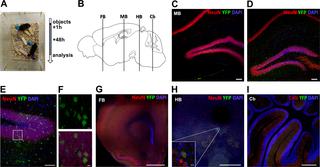PLOS Biology ( IF 9.8 ) Pub Date : 2020-03-16 , DOI: 10.1371/journal.pbio.3000643 Ivan-Maximiliano Kur 1 , Pierre-Hugues Prouvot 2, 3 , Ting Fu 2 , Wei Fan 3 , Felicia Müller-Braun 4 , Avash Das 5 , Saumya Das 5 , Thomas Deller 6 , Jochen Roeper 4 , Albrecht Stroh 2, 3 , Stefan Momma 1

|
Communication with the hematopoietic system is a vital component of regulating brain function in health and disease. Traditionally, the major routes considered for this neuroimmune communication are by individual molecules such as cytokines carried by blood, by neural transmission, or, in more severe pathologies, by the entry of peripheral immune cells into the brain. In addition, functional mRNA from peripheral blood can be directly transferred to neurons via extracellular vesicles (EVs), but the parameters that determine their uptake are unknown. Using varied animal models that stimulate neuronal activity by peripheral inflammation, optogenetics, and selective proteasome inhibition of dopaminergic (DA) neurons, we show that the transfer of EVs from blood is triggered by neuronal activity in vivo. Importantly, this transfer occurs not only in pathological stimulation but also by neuronal activation caused by the physiological stimulus of novel object placement. This discovery suggests a continuous role of EVs under pathological conditions as well as during routine cognitive tasks in the healthy brain.
中文翻译:

神经元活性触发体内造血细胞外囊泡的摄取。
与造血系统的交流是调节健康和疾病中脑功能的重要组成部分。传统上,进行这种神经免疫交流的主要途径是通过单个分子(例如血液所携带的细胞因子),通过神经传递,或者在更严重的病理学中,通过外围免疫细胞进入大脑。此外,来自外周血的功能性mRNA可以通过细胞外囊泡(EV)直接转移到神经元,但是决定其摄取的参数尚不清楚。使用通过外周炎症,光遗传学和多巴胺能(DA)神经元的选择性蛋白酶体抑制来刺激神经元活动的各种动物模型,我们显示了EV的血液转移是由体内神经元活动触发的。重要的,这种转移不仅发生在病理刺激中,而且还发生在新对象放置的生理刺激引起的神经元激活中。这一发现表明,电动车在病理条件下以及健康大脑的常规认知任务中具有持续作用。


























 京公网安备 11010802027423号
京公网安备 11010802027423号